ISSN ONLINE(2319-8753)PRINT(2347-6710)
ISSN ONLINE(2319-8753)PRINT(2347-6710)
N.Sreenivasa Babu1, Dr. K. Jayathirtha Rao2
|
| Related article at Pubmed, Scholar Google |
Visit for more related articles at International Journal of Innovative Research in Science, Engineering and Technology
Aerodynamic drag and heating are the crucial in the thermal stability of hypersonic vehicles at various speeds. The latest developments in the design of nose cone structure demands an effective Thermal Protection System (TPS) meets the need of the space research technology. In this research a typical nose cone with different Ultra High Temperature (UHT) ceramic composite TPS materials like Hafnium diboride (HfB2) and zirconium diboride (ZrB2) is analyzed and compared for its effective protection against transfer of heat into the structure. A naval model is designed for from the concepts of blunt nose cone and analyzed with the commercial software. A typical quad 4 node element is adopted to perform thermal analysis in ANSYS software and the simulated results are validated with numerical solutions. Existing ablative materials like SLA-561V, SIRCA and AVCOAT are having the heat flux ranges up to 110 W/cm2 and temperatures ranging up to 2000ËC and need of new materials and its reliability are focused in this research.
Keywords |
| Thermal Protection System, Thermal stability, blunt nose cone, UHT ceramic Composite. |
| Nomenclature: |
| T : temperature in °k |
| N : shape function in terms of temperature |
| ke : characteristic matrix N/°k |
| kx : thermal conductivity in (W/mm-K) |
| E : Young’s modulus in N/mm2 |
| 1/m : Poisson’s ratio |
| ρ : density of the material in kg/mm3 |
| α : heat transfer film co-efficient (°k-1) |
| P : perimeter of the element in mm |
| fe : forcing function matrix in N |
INTRODUCTION |
| In the recent years space vehicles like rockets, reentry vehicles regardless their unique designs needed control surfaces at hypersonic speeds. Low-radius leading edges are subject to much greater aerodynamic heating than blunt edges, such as those on the Space Shuttle, and they thus will reach temperatures that may exceed 2000°C during reentry. Available thermal protection materials will not survive such extreme temperatures and new materials are required for advanced thermal protection systems. Thus they need advanced and latest ultra high temperature ceramic materials [2006] used as a TPS layers which have high resistance in heat and oxidation. Ronald Loehman, Erica Corral, Hans Peter Dumm, Paul Kotula and Raj Tandon described the qualities of Hafnium diboride (HfB2) (melting temperature of 3250°C) and zirconium diboride (ZrB2) (melting temperature of 3246°C) [1] for their existence in proving the further research activities of the hypersonic re-entry vehicles. TPS has not only to resist high temperature and oxidation properties but also should have thermal shock property which can improve by improving fracture properties of the materials. Thermal shock stability for ZrB2-SiCp-Graphite (ZSG) and ZrB2-SiCp-AlN (ZSA) was investigated by Baoliang Liu, Jianguo Wang and Guoqian Liu [2011]. The surface cracks appeared after it was cooled from 1200°C due to thermal shock instability of the material. Residual flexural strength of ZSA was improved by crack healing after it was cooled from 1450°C. However, no surface crack appeared for ZSG after water quenching test and it provided a potential method for improving thermal shock stability of zirconium diboride ceramic matrix composites by introducing proper quantities of graphite [2]. The sphere-cone is a spherical section with a frustum or blunted cone attached. The sphere-cone's dynamic stability is typically better than that of a spherical section. With a sufficiently small half angle and properly placed center of mass, a spherecone can provide aerodynamic stability from Keplerian entry to surface impact [2009]. The "half-angle" is the angle between the cone's axis of rotational symmetry and its outer surface, and thus half the angle made by the cone's surface edges. "SLA" in SLA-561V stands for "Super Light weight Ablator". SLA-561V is a proprietary ablative made by Lockheed Martin that has been used as the primary TPS material on all of the 70 degree sphere-cone entry vehicles sent by NASA to Mars. SLA-561V begins significant ablation at a heat flux of approximately 110 W/cm², but will fail for heat fluxes greater than 300 W/cm². The Mars Science Laboratory (MSL) aero shell TPS is currently designed to withstand a peak heat flux of 234 W/cm². Phenolic Impregnated Carbon Ablator, Silicone Impregnated Reusable Ceramic Ablator (SIRCA), AVCOAT are also existed but the field demands for the new materials [3-4]. A typical design is adopted in evaluating the performance of blunt nose cone at hypersonic speeds with different materials and mode shapes also determined in acoustic nature considering the temperature effect on the surface [2013] for its feasibility for further studies [5]. Based on the same design a spherical blunt nose cone is chosen with TPS layer in the present analysis with two different ceramic materials. |
II. PROBLEM DESCRIPTION AND METHODOLOGY |
| The co-ordinates for the development of blunt cone profile is taken into consideration with respect to the tangency point and in which the basic size of the nose cone is given in key points as (11.55,0), (76,0), (76,37), (13.7833, 7.66), (10.95, 4.3), (76,38.5), (10.95,5.8), (9.75,4.3), (10.55,0). Base material for the nose cone is carbon epoxy and the TPS materials are Hafnium diboride (HfB2) and zirconium diboride (ZrB2) and their properties are as listed in Table: 1 [4] for performing the analysis. A layer of 1.5 mm is taken for the analysis purpose for each of the TPS material. |
 |
III. FEM MODELING |
| The FEM model is generated from the key points as furnished in the problem description. In the context of the model the actual model follows the steps of operations like from points to lines, lines to areas and free meshing methodologies available in the software. An axisymmetric model is chosen for the better approach to the solution as the time and data storage can be promisingly minimized with such model. The end boundary conditions are chosen based on the realistic nose cone structure of hypersonic vehicle and later thermal analysis is performed. |
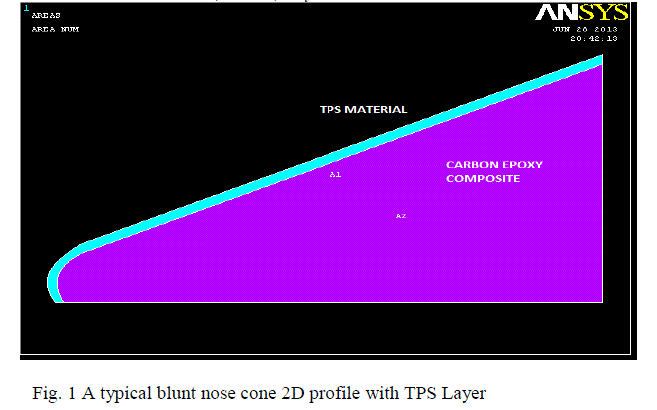 |
IV. MATHEMATICAL MODELING |
| A simple mathematical model is adopted for the validation of the actual conditions of the composite structure for its thermal analysis from the fundamentals of FEM procedures. A cantilever beam with two materials is an acceptable model to satisfy the problem. The governing equation for this condition with an isotropic body with temperature-dependent heat transfer has the form of global equations for the domain can be assembled using connectivity information. Shape functions Ni are used for interpolation of temperature inside a finite element as per equation (1) is given by[6] |
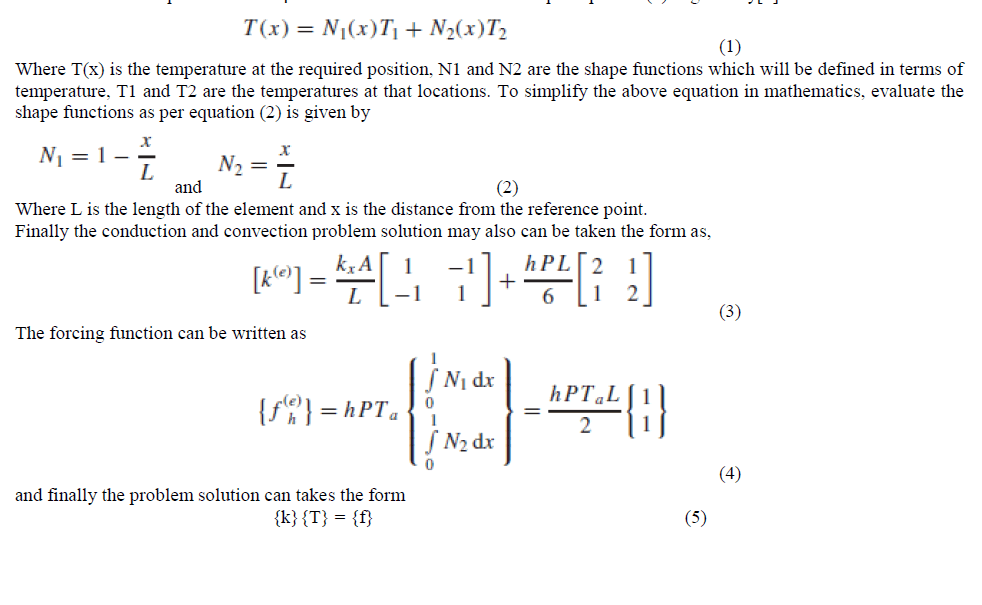 |
VI. RESULTS AND DISCUSSIONS |
| A 2D model is analyzed for its steady state heat transfer analysis by using Newton Raphson model at Mach number 10 for hypersonic environment and the surface temperature is taken as 2478°k and boundary temperature of 298°k [3]. A total number of 1157 elements are taken for its final solution convergence. |
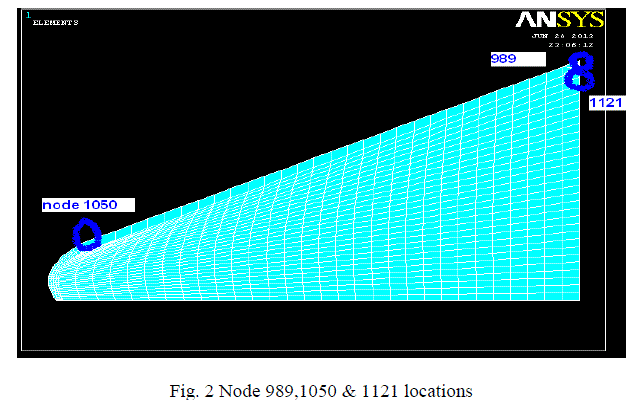 |
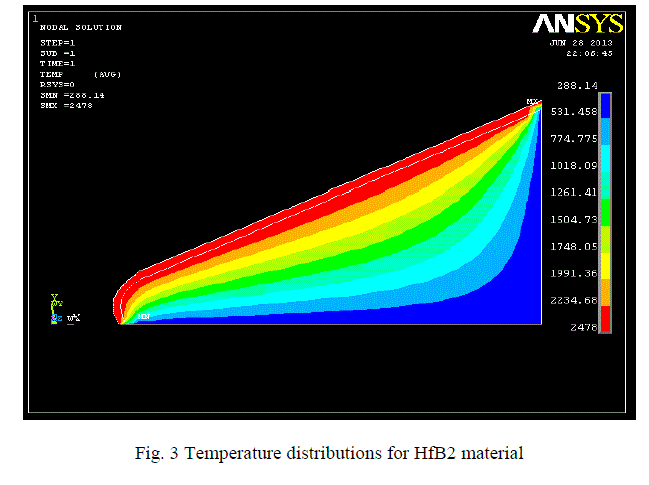 |
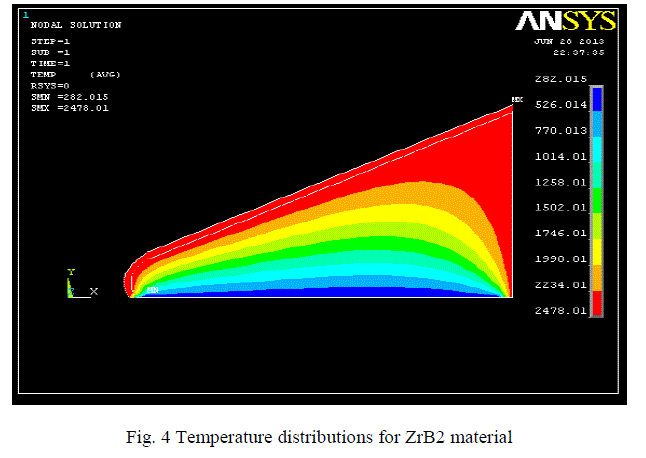 |
 |
 |
| The node numbers are chosen for mathematical solutions at 1050, 989 and 1121 at the radii of the nose cone 5 mm, 37mm and 38.5 mm respectively and the solutions were compared. |
 |
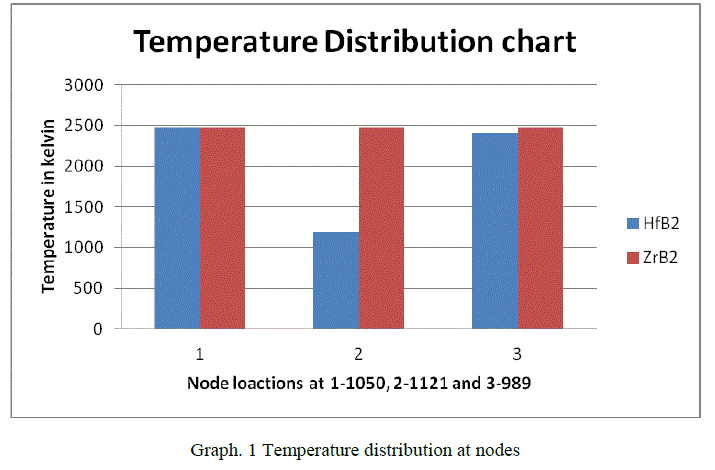 |
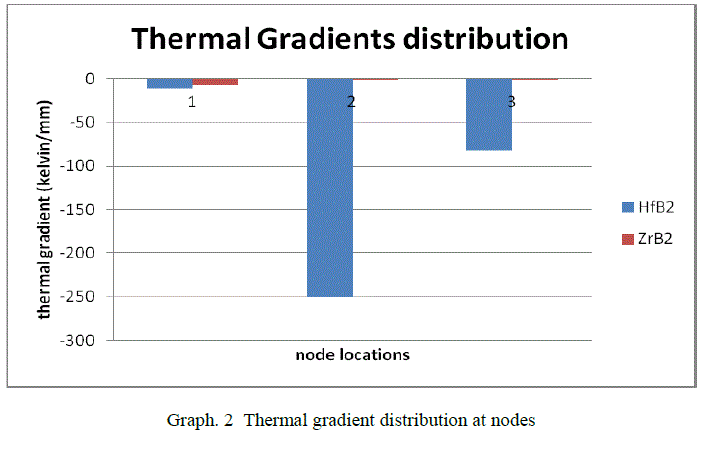 |
 |
VII. CONCLUSIONS |
| Simulated solutions at various nodes are validated with numerical solutions which are fairly in good understanding and show the feasibility of the problem methodology. |
| For the Hafnium diboride material the temperature distribution is from 2478°k to 2411.58°k and the distribution is normal showing the uniformity of the distribution over the entire nose cone as in figure 3. |
| But for the Zirconium diboride material the temperature distribution is not same and it is 2478°k at the skin of the TPS layer and shows the resistance of the material in transferring the temperature for the remaining of the nose cone as in figure 4. |
| From the simulated results the Hafnium diboride material shows the better distribution pattern and its heat flux values are also in promising levels than Zirconium diboride material. |
| This can be further evaluated for the transient thermal analysis which may have additional solutions for the defined problem. |
References |
|